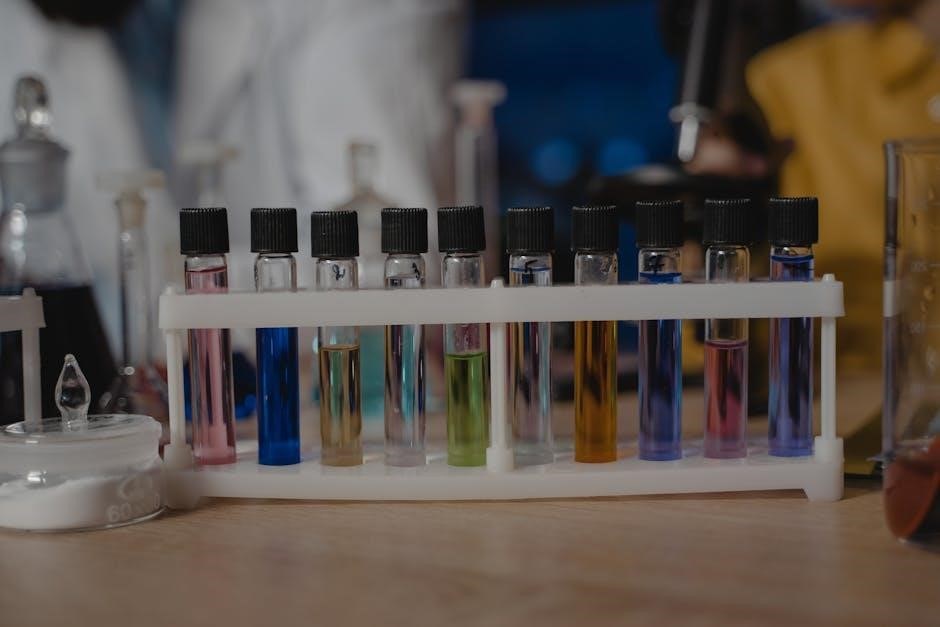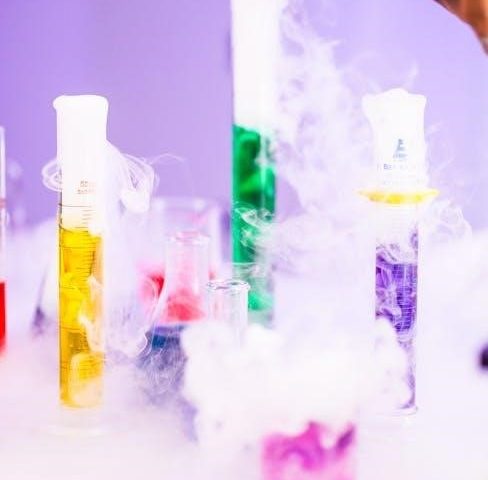The True Colors Test PDF is a popular tool for understanding personality traits and behavior. It helps individuals identify their core strengths and preferences.
1.1 What is the True Colors Test?
The True Colors Test is a widely recognized personality assessment tool designed to identify an individual’s core traits and preferences. Based on four primary colors—Orange, Gold, Green, and Blue—it categorizes personalities into distinct types. Each color represents specific characteristics, such as creativity, organization, analysis, or empathy. The test provides insights into strengths, weaknesses, and communication styles, making it a popular choice for self-discovery and interpersonal understanding. It is often used in educational and professional settings to foster collaboration and personal growth.
By simplifying complex personality theories, the True Colors Test offers an accessible and engaging way to explore individual differences. Its user-friendly format and practical applications have made it a favorite among educators, employers, and individuals seeking self-awareness.
1.2 Purpose of the Test
The primary purpose of the True Colors Test is to enhance self-awareness and improve interpersonal relationships. By identifying personality types, it helps individuals understand their strengths and weaknesses. The test fosters empathy and collaboration, making it ideal for team-building, education, and workplace environments. Its goal is to create a common language for discussing differences, promoting mutual understanding and respect. The test also serves as a tool for personal growth, enabling individuals to leverage their strengths and address areas for development effectively.
Overall, the test aims to empower individuals and groups to communicate more effectively and work harmoniously together.

History and Development of the True Colors Test
The True Colors Test was created by Don Lowry in 1978 to help individuals understand personality differences. It has since evolved into a widely used tool for self-awareness and team-building.
Its development focused on simplifying complex personality theories into a practical, accessible framework. Over the years, the test has been refined to better cater to diverse audiences and applications.
Today, the True Colors Test remains a popular and effective method for fostering understanding and collaboration in both personal and professional settings.
2.1 Origins of the Test
The True Colors Test was created by Don Lowry in 1978 as a practical tool for understanding personality differences. Initially designed for educational settings, it aimed to simplify complex psychological concepts into an accessible format. The test uses a four-color system—orange, green, blue, and gold—to represent distinct personality traits. Its origins lie in Lowry’s desire to help individuals and groups identify their strengths and preferences, fostering better communication and collaboration. Over time, the test has evolved but retains its core mission of promoting self-awareness and interpersonal understanding. Its simplicity and effectiveness have made it a widely recognized and utilized assessment tool.
2.2 Evolution Over Time
The True Colors Test has undergone significant updates since its creation in 1978. Initially a paper-based assessment, it transitioned to digital formats, including the widely-used PDF version, enhancing accessibility. Updates have refined the questioning and scoring systems to improve accuracy and relevance. The test now incorporates modern psychological insights, making it more adaptable to diverse audiences. Its evolution reflects growing demand for practical, user-friendly tools in education and professional settings. The PDF format has played a key role in its global distribution and popularity.
2.3 The Role of PDF in its Distribution
The PDF format has been instrumental in the widespread adoption of the True Colors Test. Its portability and compatibility across devices make it easily accessible to users worldwide. PDFs allow for consistent formatting and quick distribution via email or online platforms. This accessibility has enabled educators, professionals, and individuals to use the test without needing specialized software. The PDF version also supports offline use, ensuring its availability in various settings. Its convenience has significantly contributed to the test’s popularity and reach across different industries.

Key Concepts of the True Colors Test
The True Colors Test is a personality framework that categorizes individuals into four color types, each representing distinct traits and communication styles. It helps users understand their behaviors, strengths, and preferences, fostering self-awareness and interpersonal connections. Widely used in education and professional settings, it promotes effective teamwork and personal growth.
3.1 The Four Personality Types
The True Colors Test categorizes personalities into four types: Orange, Gold, Green, and Blue. Each color represents distinct traits and tendencies. Orange personalities are energetic and action-oriented, while Gold individuals value structure and organization. Green types are analytical and logical, and Blue personalities emphasize empathy and harmony. These categories help individuals recognize their strengths and weaknesses, improving self-awareness and interpersonal relationships. By understanding these differences, people can adapt their communication styles and collaborate more effectively. This framework fosters personal growth and teamwork across various settings.
3.2 Color Associations and Their Meanings
In the True Colors Test, each color represents specific traits and behaviors. Orange symbolizes energy and spontaneity, while Gold reflects structure and responsibility. Green embodies logic and analysis, and Blue represents empathy and harmony. These color associations help individuals understand their natural tendencies, decision-making styles, and communication preferences. By aligning with their dominant color, individuals can identify strengths, address weaknesses, and improve interactions with others. This color-based system provides a clear framework for self-reflection and personal development, making it accessible and relatable for diverse audiences. It also fosters mutual understanding in team and social settings.
3.3 How the Test Works
The True Colors Test PDF is a self-assessment tool that identifies personality traits through a series of questions. Participants select statements or colors that resonate with them, reflecting their preferences. The test categorizes responses into four colors: Orange, Gold, Green, and Blue. Each color represents distinct behaviors and tendencies. After completing the test, users tally their scores to determine their dominant color(s). This reveals insights into communication styles, decision-making, and interpersonal interactions. The test is designed to be straightforward, providing clear results that promote self-awareness and personal growth. Its simplicity makes it accessible for individuals and groups alike.

Benefits of Using the True Colors Test PDF
The True Colors Test PDF enhances self-awareness, improves communication, and fosters team collaboration. It provides practical insights for personal and professional development, making it a valuable tool.
4.1 Self-Awareness and Personal Growth
The True Colors Test PDF helps individuals gain insight into their personality, strengths, and weaknesses. By understanding their color profile, users can identify personal growth areas and develop self-awareness. This tool encourages introspection, allowing people to align their goals with their natural tendencies; It fosters emotional intelligence and self-acceptance, empowering individuals to make informed decisions. The test also highlights how personality traits influence behavior, providing a foundation for personal development and self-improvement. This self-awareness is key to unlocking potential and achieving a more balanced life.
4.2 Improved Communication Skills
The True Colors Test PDF enhances communication by revealing how personality types interact. Understanding color profiles helps individuals adapt their communication style to others. This fosters empathy and reduces misunderstandings. By recognizing strengths and weaknesses, users can tailor their approach to different audiences. The test encourages active listening and clarity in expression. Improved communication leads to stronger relationships and collaboration. This tool is especially valuable in diverse environments, where understanding others’ perspectives is crucial. Effective communication builds trust and mutual respect.
4.3 Team Building and Collaboration
The True Colors Test PDF is a valuable tool for fostering team building and collaboration. By identifying personality types, it helps teams balance strengths and weaknesses. Understanding color profiles enables members to appreciate diverse perspectives, enhancing teamwork. This insight promotes effective role assignment and reduces conflicts. Teams can leverage individual strengths, such as leadership, creativity, or organization. The test encourages open dialogue and mutual respect, leading to stronger bonds. It is particularly useful for creating high-performing teams and improving overall cohesion. This fosters a collaborative environment where everyone feels valued and contributes meaningfully.
4.4 Educational and Professional Applications
The True Colors Test PDF is widely used in educational and professional settings to enhance learning and workplace dynamics. In education, it helps teachers tailor instruction to students’ preferences, improving engagement. In the workplace, it aids in hiring, training, and career development. By understanding personality types, educators and employers can create environments that foster productivity and satisfaction. This tool bridges communication gaps, enabling better guidance and mentorship. Its versatility makes it a valuable resource for both academic and corporate environments, promoting success and growth.

How to Take the True Colors Test Using a PDF
The True Colors Test PDF is simple to use, offering a clear format for self-assessment. Download the test, follow instructions, and answer questions to reveal insights.
5.1 Downloading the Test
Downloading the True Colors Test PDF is straightforward. Visit the official website or trusted sources offering the test. Ensure the file is from a reliable provider to avoid errors. Once found, click the download button to save the PDF. The file typically includes instructions and the test itself. Make sure your device has a PDF reader installed; Before starting, review the guidelines to understand the process. The test is designed to be self-administered, making it accessible for individuals or groups. Always verify the source for authenticity to ensure accurate results.
5.2 Understanding the Test Format
The True Colors Test PDF is structured to be user-friendly. It typically begins with an introduction explaining the purpose and instructions. The test consists of a series of questions or statements, often asking you to rank or select preferences. Each question is designed to assess your alignment with the four primary colors. The format may include multiple-choice options or ranking systems. Instructions are clear, guiding you through the process step-by-step. Understanding the format ensures you can complete the test accurately and interpret the results effectively. Always read the directions carefully before starting.
5.3 Completing the Test
Completing the True Colors Test PDF is straightforward. Answer the questions honestly, selecting responses that best reflect your typical behavior. The test is quick, with most versions taking 10–15 minutes. Each question is designed to assess your preferences and tendencies. After answering all questions, review your responses to ensure accuracy. Some tests allow you to tally your scores manually, while others provide instant results; Be sure to follow the instructions carefully to interpret your colors accurately. Take your time, and avoid rushing through the process. Your honest input ensures reliable results.

Interpreting Your True Colors Test Results
Interpreting your True Colors Test results reveals your personality insights. Understand your color profile, strengths, and weaknesses. This helps in personal and professional growth effectively.
6.1 Understanding Your Color Profile
Your color profile reveals your dominant and secondary colors, providing insights into your personality, strengths, and tendencies. Each color represents specific traits: Orange for spontaneity, Green for analysis, Blue for empathy, and Gold for organization. Understanding your profile helps identify how you interact with others and approach tasks. It also highlights areas for personal growth and how to leverage your natural abilities effectively in various situations. This self-awareness is key to developing strategies for improvement and fostering better relationships.
Analyzing your scores involves evaluating the numerical values assigned to each color in your profile. Higher scores indicate stronger tendencies toward specific traits, while lower scores suggest less prominence. Comparing these scores helps identify your primary and secondary colors, revealing your unique personality blend. This analysis allows you to understand your strengths and areas for development. By examining the distribution of scores, you can gain clarity on how your colors influence your behavior and interactions, enabling a more accurate interpretation of your True Colors profile. Identifying strengths and weaknesses involves reviewing your color profile to understand your natural inclinations and potential challenges. Each color highlights specific traits, such as leadership, creativity, or empathy. By evaluating your dominant and secondary colors, you can pinpoint areas where you excel and where improvement is needed. For example, a high Orange score may indicate adaptability but also a tendency to avoid planning. Recognizing these aspects helps you leverage your strengths while addressing weaknesses, fostering personal and professional growth. This self-awareness is key to effective development. Applying insights from the True Colors Test helps individuals enhance communication, build stronger relationships, and make informed career decisions aligned with their personality strengths. The True Colors Test PDF offers valuable insights for personal growth. By identifying strengths and weaknesses, individuals can set realistic goals and develop strategies to improve. For example, those with dominant Blue traits may focus on enhancing flexibility, while Gold personalities might work on adaptability. The test encourages self-reflection and provides actionable steps to foster emotional intelligence and resilience. These strategies empower individuals to align their actions with their core values, leading to a more fulfilling and balanced life. Regular self-assessment and mindful practice are key to sustained development. The True Colors Test PDF helps improve workplace dynamics by fostering understanding among colleagues. By recognizing different personality types, employees can adapt their communication styles to better connect with others. For instance, Orange personalities can engage Blue coworkers by focusing on logic and clarity, while Green individuals can mediate conflicts. This awareness promotes empathy and reduces misunderstandings, creating a more collaborative environment. Teams that embrace these insights often experience increased trust, improved problem-solving, and enhanced overall productivity, leading to a positive workplace culture. Effective relationship-building is key to long-term success. The True Colors Test PDF enhances academic success by helping students and educators understand individual learning styles. By identifying their personality type, students can adopt study habits that align with their strengths. For example, Blue learners thrive with structured schedules, while Orange personalities excel with hands-on activities. Educators can tailor teaching methods to meet diverse needs, fostering engagement and retention. This personalized approach leads to improved grades, reduced stress, and a more fulfilling educational experience for students and teachers alike. The True Colors Test PDF aids educators in creating personalized learning experiences, fostering better teacher-student relationships, and enhancing overall academic environments for student success and growth. The True Colors Test PDF helps students identify their learning preferences by aligning their personality traits with effective study habits. By understanding their dominant colors, students can recognize whether they thrive in structured, creative, or collaborative environments. This self-awareness enables them to adapt their learning strategies, such as focusing on visual, auditory, or hands-on approaches. Educators can use these insights to tailor teaching methods, fostering a more inclusive and effective learning experience. This personalized approach empowers students to achieve their academic goals with greater confidence and success. The True Colors Test PDF enhances classroom dynamics by encouraging understanding and collaboration among students. By identifying their personality types, students can appreciate diverse perspectives, fostering empathy and respect. Teachers can use this tool to create balanced groups, ensuring a mix of personalities that promote creative problem-solving and teamwork. This approach helps minimize conflicts and maximizes engagement, creating a positive and inclusive learning environment. It also encourages students to value individual differences, leading to stronger interpersonal connections and a more cohesive classroom culture. The True Colors Test PDF empowers educators to tailor their teaching methods by understanding students’ personality types. By identifying dominant and secondary colors, teachers can adapt lesson plans to meet diverse learning needs. For example, Orange personalities may thrive in action-oriented tasks, while Gold individuals respond well to structured, organized environments. This insight allows teachers to create personalized learning experiences, enhancing engagement and academic success. The test also helps educators communicate more effectively with students, fostering a supportive and inclusive classroom atmosphere. The True Colors Test helps organizations understand team dynamics, improve communication, and enhance leadership effectiveness. It fosters collaboration and harmonious work environments by aligning roles with strengths. The True Colors Test is instrumental in building effective teams by identifying complementary personality traits. It helps organizations understand individual strengths and weaknesses, fostering collaboration and reducing conflicts. By aligning roles with natural tendencies, teams achieve better synergy and productivity. This tool also promotes mutual respect among members, creating a positive work environment. Ultimately, it enhances communication and ensures that diverse perspectives contribute to shared goals, leading to stronger and more cohesive teams. The True Colors Test PDF provides insights into conflict resolution by identifying personality-driven communication styles. Understanding individual color profiles helps pinpoint emotional triggers and approaches to disputes; By addressing these differences, teams can adopt tailored strategies to mediate conflicts effectively. The test encourages active listening, empathy, and adaptability, fostering a respectful environment for resolution. It also highlights how different colors prefer to handle disagreements, enabling targeted approaches to de-escalate tensions. This tool equips individuals and teams with practical methods to transform conflicts into opportunities for growth and collaboration. The True Colors Test PDF serves as a valuable resource for leadership development by identifying natural leadership styles tied to personality types. It helps aspiring leaders recognize their strengths and areas for improvement. By understanding their color profile, individuals can adapt their approach to inspire and motivate diverse teams. The test also provides insights into decision-making, communication, and conflict resolution, which are essential for effective leadership. This tool empowers leaders to create inclusive environments where team members feel valued and engaged, fostering productivity and success. Real-world applications of the True Colors Test PDF have shown transformative results in education and corporate settings, fostering personal and team growth through color-based insights. Many schools and universities have integrated the True Colors Test PDF into their programs to enhance student self-awareness and classroom dynamics. Educators use it to identify diverse learning styles, fostering inclusive environments. Students benefit by understanding their strengths, improving collaboration, and developing better study habits. The test has also helped teachers tailor instruction methods, leading to improved academic performance and stronger student-teacher relationships. Its simplicity and effectiveness make it a valued resource in educational settings worldwide. Numerous corporations have adopted the True Colors Test PDF to enhance workplace dynamics and productivity. Companies like Google and Microsoft use it to build effective teams and improve communication. The test helps employees understand their colleagues’ personalities, fostering collaboration and reducing conflicts. Leadership development programs often incorporate the test to identify potential managers and strengthen decision-making skills. By promoting self-awareness and empathy, the True Colors Test has become a valuable tool for creating a positive and productive corporate culture. Its impact is evident in improved employee engagement and overall business performance. Many individuals have shared positive experiences with the True Colors Test PDF, highlighting its impact on personal and professional growth. Users often mention enhanced self-awareness, improved relationships, and better decision-making skills. For instance, one professional credited the test with helping them transition into a leadership role by understanding their strengths. Another individual noted how it improved communication with family and colleagues. The test’s simplicity and insights have made it a cherished resource for those seeking self-improvement and stronger connections in their daily lives. Its practical applications continue to inspire users worldwide. The True Colors Test PDF is a valuable tool for self-discovery and growth, offering insights into personality and behavior. It empowers individuals and teams to thrive. The True Colors Test PDF is a widely-used assessment tool designed to help individuals understand their personality, strengths, and preferences. By categorizing users into four primary colors—Orange, Gold, Green, and Blue—it provides insights into behavioral tendencies and communication styles. The test is valued for its simplicity and practical applications in both personal and professional settings. It encourages self-awareness, improved relationships, and effective teamwork, making it a versatile resource for growth and development across various aspects of life. The True Colors Test PDF is a valuable, accessible tool for fostering self-awareness and improving interpersonal connections. Its simplicity and practical insights make it widely applicable in both personal and professional contexts. By providing a clear framework for understanding personality traits, it empowers individuals to communicate more effectively and build stronger relationships. Whether for personal growth, education, or workplace dynamics, the True Colors Test PDF remains a timeless and versatile resource for enhancing self-understanding and collaboration. Its enduring popularity speaks to its lasting impact.6.2 Analyzing Your Scores
6.3 Identifying Strengths and Weaknesses

Applying the Insights from the True Colors Test
7.1 Personal Development Strategies
7.2 Enhancing Workplace Relationships
7.3 Improving Academic Performance

The Role of the True Colors Test in Education
8.1 Helping Students Understand Their Learning Styles
8.2 Fostering Classroom Dynamics
8.3 Supporting Teachers in Tailored Instruction

The Role of the True Colors Test in the Workplace
9.1 Building Effective Teams
9.2 Conflict Resolution Strategies
9.3 Leadership Development

Case Studies and Success Stories
10.1 Educational Institutions Using the Test
10.2 Corporations That Have Benefited
10.3 Individual Testimonials
11.1 Recap of the True Colors Test PDF
11.2 Final Thoughts on Its Value
